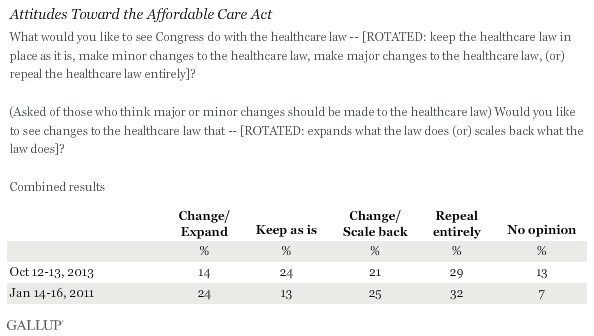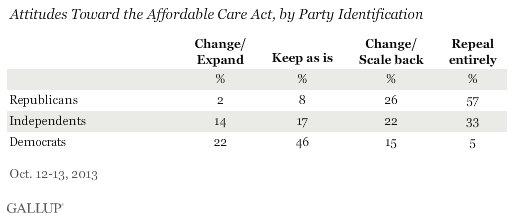PRINCETON, NJ -- Half of Americans today want the Affordable Care Act repealed or scaled back, down from 57% in January 2011. There has been essentially no change in the percentage of Americans who want the law expanded or kept as it is.

The Affordable Care Act became an integral part of the ongoing wrangling between Republicans and Democrats that led to the partial federal government shutdown on Oct. 1, with conservative Republican lawmakers initially attempting to connect any vote on funding the government to defunding the ACA. A minority of Americans would agree that the law should be totally repealed, the functional equivalent of defunding.
Mirroring the rancorous partisan debate over the ACA in Congress, views on the law are predictably split between Americans who identify as Republicans and those who identify as Democrats. A majority of Republicans (57%) say it should be repealed, with most of the rest desiring changes that would scale the law back. On the other hand, a little less than half of Democrats say the ACA should be kept as is, while 22% favor changes to expand the law. Notably, a not insubstantial 15% of Democrats want the law scaled back.

Bottom Line
Consistent with surveys showing that Americans tilt more negatively than positively toward the Affordable Care Act, Americans remain more likely to say the law should be scaled back or repealed rather than kept as is or expanded, although only three in 10 want it repealed outright. Compared with January 2011, however, fewer Americans want the law repealed or scaled back, and more now don't have an opinion.
Survey Methods
Results for this Gallup poll are based on telephone interviews conducted Oct. 12-13, 2013, on the Gallup Daily tracking survey, with a random sample of 1,039 adults, aged 18 and older, living in all 50 U.S. states and the District of Columbia.
For results based on the total sample of national adults, one can say with 95% confidence that the margin of sampling error is ±4 percentage points.
Interviews are conducted with respondents on landline telephones and cellular phones, with interviews conducted in Spanish for respondents who are primarily Spanish-speaking. Each sample of national adults includes a minimum quota of 50% cellphone respondents and 50% landline respondents, with additional minimum quotas by region. Landline and cell telephone numbers are selected using random-digit-dial methods. Landline respondents are chosen at random within each household on the basis of which member had the most recent birthday.
Samples are weighted to correct for unequal selection probability, nonresponse, and double coverage of landline and cell users in the two sampling frames. They are also weighted to match the national demographics of gender, age, race, Hispanic ethnicity, education, region, population density, and phone status (cellphone only/landline only/both, and cellphone mostly). Demographic weighting targets are based on the March 2012 Current Population Survey figures for the aged 18 and older U.S. population. Phone status targets are based on the July-December 2011 National Health Interview Survey. Population density targets are based on the 2010 census. All reported margins of sampling error include the computed design effects for weighting.
In addition to sampling error, question wording and practical difficulties in conducting surveys can introduce error or bias into the findings of public opinion polls.
View methodology, full question results, and trend data.
For more details on Gallup's polling methodology, visit www.gallup.com.
